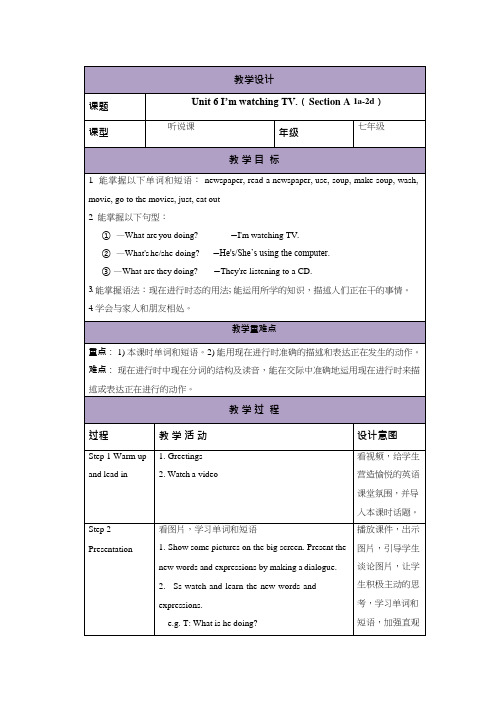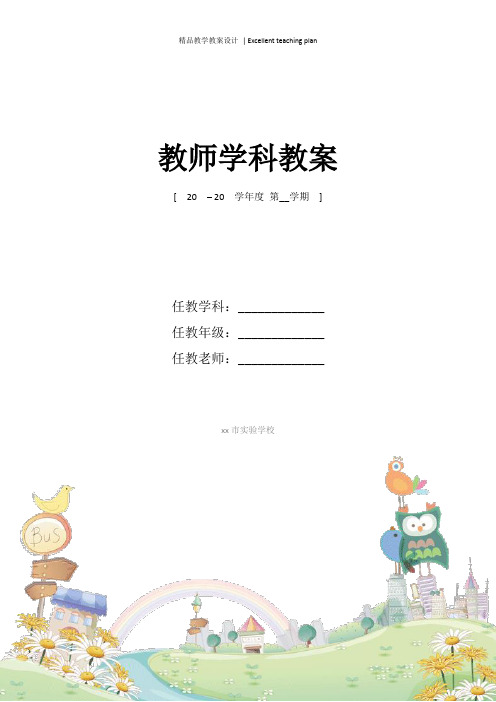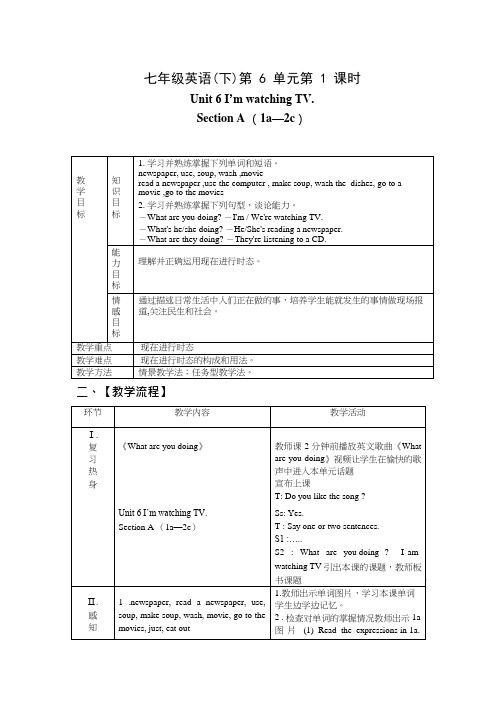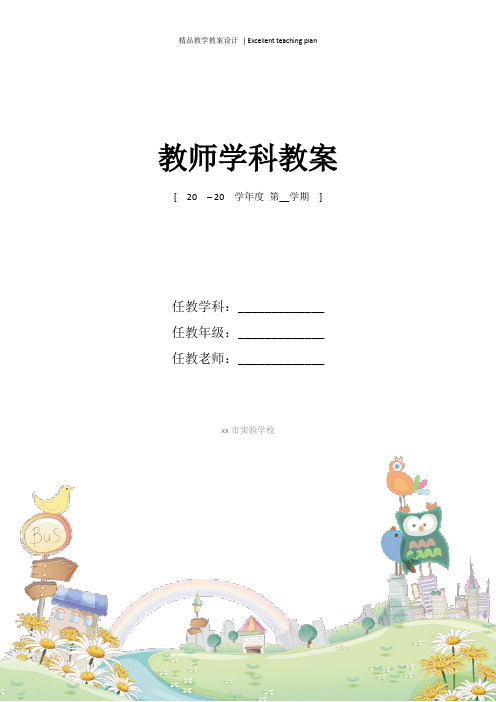最新精编Unit 6 I’m watching TV Section A(第2课时)教案
- 格式:doc
- 大小:108.50 KB
- 文档页数:2

教学设计课题Unit 6 I’m watching TV.(Section A 1a-2d)课型听说课年级七年级教学目标1.能掌握以下单词和短语:newspaper, read a newspaper, use, soup, make soup, wash, movie, go to the movies, just, eat out2.能掌握以下句型:① —What are you doing? —I'm watching TV.② —What's he/she doing? —He's/She’s using the computer.③ —What are they doing? —They're listening to a CD.3.能掌握语法:现在进行时态的用法; 能运用所学的知识,描述人们正在干的事情。
4.学会与家人和朋友相处。
教学重难点重点:1) 本课时单词和短语。
2) 能用现在进行时准确的描述和表达正在发生的动作。
难点:现在进行时中现在分词的结构及读音,能在交际中准确地运用现在进行时来描述或表达正在进行的动作。
教学过程过程教学活动设计意图Step 1 Warm up and lead in 1.Greetings2.Watch a video看视频,给学生营造愉悦的英语课堂氛围,并导入本课时话题。
Step 2 Presentation 看图片,学习单词和短语1.Show some pictures on the big screen. Present thenew words and expressions by making a dialogue.2.Ss watch and learn the new words andexpressions.e.g. T: What is he doing?播放课件,出示图片,引导学生谈论图片,让学生积极主动的思考,学习单词和短语,加强直观。

Unit6 I'm watching TV第3课时 SectionA2a-2c 精品同步教案一、教材分析本课时以“I’m watching TV”为中心,学习表示“正在进行”的现在进行时态。
2a部分主要通过图片让学生理解动作正在进行,并与现在进行时态搭配,牢记现在分词的用法。
2b部分通过真实场景练习学生的口语表达能力,2c部分通过听力练习学生的听力能力。
二、教学目标1.掌握现在进行时态的基本构成及用法。
2.学会运用现在进行时态描述正在进行的事情。
3.训练学生的口语和听力能力。
三、教学重难点1.现在进行时态的构成和用法。
2.通过图片和日常实际场景的练习巩固现在进行时态的表达。
四、教学过程1.引入(5分钟)展示一些图片让学生回忆英语单词,然后引出“I’m watching TV”这句话。
问学生已经知道的“看电视”的英文如何表达?引导学生完成“I’m watching TV”这句话。
2.听力训练(15分钟)教师播放一段录音,学生跟读,强化学生的发音、语调及口语表达能力。
3.2a部分的学习(15分钟)1)展示图片,教师引导学生说出图片中正在进行的动作,如“swimming”、“playing soccer”等。
同时,告诉学生这些动作都是正在进行的,使用“现在进行时态”可以表达。
应该是“is swimming”、“is playing soccer”等。
2)学生自行编造几个图片中的动作,让搭档进行描述,增加学生的口语练习。
4.2b部分练习(10分钟)教师在黑板上写下“what are you doing?”的问题,然后找一个学生进行对话,老师充当另一个角色。
学生1先问老师“what are you doing?”,老师会回答“ I’m doing my homework.”学生1继续说下一句话,“I’m watching TV.”然后让学生2提问“what are you doing?”学生2回答并将句子接上去,如此类推。

教师学科教案[ 20 – 20 学年度第__学期]任教学科:_____________任教年级:_____________任教老师:_____________xx市实验学校《新目标》英语七年级下册Unit 6 I’m watching TV. (Section B 2a --- 2c)教学设计和教学反思教学目标:知识与技能目标:1. 能正确使用阅读篇章中出现的重点词汇和常用表达。
2. 能准确使用现在进行时谈论人们正在做的事情。
3. 能根据语境使用一般现在时与现在进行时表述现在。
4. 能运用阅读技巧及多项语言实践活动深入理解文章。
过程与方法目标:1. 学会边听边做笔记,捕捉关键信息。
2. 能通过参与课堂、完成对话和小组活动等方式完成主动合作和探究式学习。
情感态度价值观目标:1. 了解中西方文化的不同以及各国之间存在的时差现象。
2. 了解端午节,学会尊重并热爱中国的传统文化。
教学重点:1. 掌握阅读文章中出现的重点词汇和常用表达。
2. 准确使用现在进行时谈论人们正在做的事情。
3. 多角度设计活动深入理解文章。
教学难点:1. 能根据语境使用一般现在时与现在进行时表述现在。
2. 灵活运用所学语言解读文章并表达个人观点。
教学方法:创设情境法、口语交际法教学过程:Step 1 Lead inT: First let’s do something to relax ourselves. Imagine: You are free today. You can go to any place, for example, the zoo, the park, the cinema, etc. You can do anything you like, for example, play games, see a film, play sports, and so on. Now, tell me: Where are you? And what are you doing?The students make sentences with the Present Progressive Tense.设计意图:通过学生想象,创设情境。

七年级英语(下)第 6 单元第 1 课时
Unit 6 I’m watching TV.
Section A (1a—2c)
二、【教学流程】
newspaper, read a newspaper, use, soup, 结合板书和课件,让学生盘点所学单
She /He is….
I’m watching TV . What is she /he doing ?
Soup wash Movie
What are you / they doing ? Newspaper use Unit 6 I’m watching TV.
Section A (1a —2c )
三、【板书设计】
四、【教后反思】
本节课结合教材重点、难点及英语学科特点,利用多媒体辅助教学,从看、听、说等方面使学生得到锻练,引导学生在轻松,愉快的教学环境中较容易地掌握了所学的知识。
贴近学生的生活实际,容易让学生在说与做中体会与学习现在进行时态,循序渐进,逐步扩展深化,并能活跃学习思维,激发他们参与课堂活动的欲望,达到初步运用英语交际的能力, 但开口说英语对于部分学生来说是很难的,一定要鼓励学生张口说。
在完成 Let’s guess 这一环节学生做的不够好,因为学生就怕出错,所以,在今后的教学中要加强同学们的口语 训练,鼓励学生不怕出错,大胆开口。

Unit 6 I`m watching TV (教案)一.教学目标1. 语言目标:Talk about what people are doing2.语言结构:现在进行时和一般疑问句及简单的答语3. 语言技能:能用现在进行时的各种形式准确的描述和表示正在发生的动作。
二.情感目标培养同学之间的合作意识,同时提高他们的观察能力和判断能力,激发他们对学习英语的兴趣和热情。
三.教学重点及难点现在进行时的结构及应用四.教学过程Step1 Lead in通过图片来初步了解现在进行时What is she doing?She is drawing a picture.What is he doing?He is playing basketball.What are they doing?They are eating dinner.Step2.Teach the Present Progressive肯定句:主语+be+Ving否定句:主语+be+not+Ving疑问句:Be+主语+Ving肯定回答:Yes,主语+be否定回答:No,主语+be+notStep3. PracticeWhat is she doing?She is ….Step4. Let some students act several actions and say . Step5. ActivitiesWe can play games to practice what we learend. Step6. Read grammar focus.Step7.Homework1.完成3a和3b练习题。
2.读一读3a的句子。
3.自己写3各现在时的句子。

教师学科教案[ 20 – 20 学年度第__学期]任教学科:_____________任教年级:_____________任教老师:_____________xx市实验学校Unit 6 I’m watching TVSection A 1a—1c教学设计蒙城中学杨梅一.Teaching aims1.Knowledge aims:⑴Learn some new words and phrases: newspaper, read a newspaper,use, use the computer, soup, make soup, wash, wash the dishes, talk on the phone⑵Learn the key sentences:--What are you doing? --I’m watching TV.--What’s he doing? --He’s using the computer.--What’s she doing? --She’s exercising.(3)Students learn to use the Present Progressive Tense correctly.2.Ability aims:⑴Students are able to use the Present Progressive Tense correctly.⑵Improve the students’ listening, speaking and writing skills.Trainstudents’ communicative competence.3.Moral aims:Cultivate students’ love for their parents.二.Teaching important and difficult pointsImportant points: Master the key words and target language.Difficult points: How to use the Present Progressive Tense correctly..三.Teaching aids: blackboard, multi-media四.Teaching procedures:Step I.GreetingsGreet the whole class as usual, and introduce myself to the students. (Make a communication with the students to make them like me )Step II.Warming-upDivide them into two groups by their locations to do some groupcompetitions. Play a game “ I say hello, you say hi”. (Play a gameto make the students warm up)Step III.Leading-in⑴Listen to a song, and let the students listen to it carefully toremember the first sentence in the song: Are you sleeping. (Tomake the students more interested in English)⑵Free talk. Ask students “What are we doing now?”Help thestudents answer “We’re having an English class.” Ask students if they know what the meaning of the sentences is, and tell them.(Call their attention to the difference between now and every day) Step IV.Presentation⑴Show some pictures on the screen, and teach the key phrasesone by one. And change the forms of verbs, teach students to read, then ask students to find how to add –ing to the verbs.⑵Show some pictures on the screen, and teach the key sentencesone by one. Call their attention to the red letters be v-ing.Step V.Practice1.Word practice: Play a game “ Quick answer”. Show the picturesquickly and let the students stand up to say the phrases quickly.2.Key sentences practice:⑴Let students look at the screen, and then guess what he/she isdoing.⑵Let some students perform in font of the class, other studentsguess what they are doing, ask and answer.(3)Activity 1a: Ask students to look at the pictures on Page 31 andmatch the words with the activities in the picture. Then check the answers by asking some students to read the words and the letters.(4)Activity 1b: Listen and number the activities from 1a and checkthe answers.(5)Let students do pairwork. Make new conversations.Step VI.Consolidation1.Ask students to conclude the grammar: the Present ProgressiveTense. And explain it.2.Exercises⑴Describe Dick’s family;⑵Correct the mistakes.3.Show some pictures to let students know what their parents aredoing, they are very busy just for their kids.Step VII.SummarySummary the knowledge and students’ activities.Step VIII.Homework1.Learn the new words and target language by heart.2.Make a conversation using the Present Progressive Tense.3.Make a survey to talk about what their classmates are doing.五.Reflection本课时设计问题贴近学生的现实生活,问题比较容易。
Unit 6I'm watching TV.Section A(Grammar Focus-3c )Target Navigation 【目标导航】Key words and phrases:house,drink,tea,tomorrow,drink teaKey sentences:(1)—What are you doing?—I'm watching TV.(2)—What's she doing?—She's washing her clothes.(3)—Is he reading a newspaper?—Yes,he is./No,he isn't.He's playing basketball. (4)—Are they using the computer?—Yes,they are./No,they aren't.They're exercising.Skills:掌握现在进行时态的肯定式、否定式及一般疑问形式。
Emotion:通过观察别人的行为和活动,能用现在进行时来准确地表达所发生或进行的动作。
The guidance of learning methods 【学法指导】让学生观察课件画面,回答问题,让学生学会使用认知策略;让学生表演对话,实现交际策略。
Learning important and difficult points【学习重难点】区分一般现在时与现在进行时。
Teaching Steps 【教学过程】Autonomous Learning Scheme 【自主学习方案】(一)预习指导1.根据Grammar Focus,归纳Section A部分语法重点。
2.勾画出重点和疑难点。
(二)预习检测Ⅰ.翻译下面的句子。
1.我们能出去吃。
________________2.我的父母亲不在家。
________________3.你正在做什么?________________4.没忙什么。
教师学科教案[ 20 – 20 学年度第__学期]任教学科:_____________任教年级:_____________任教老师:_____________xx市实验学校新目标七年级(下)Unit 6 I’m watching TV.一. 教学课型:听说课二. 教材依据新目标英语(Go for it )七年级下册Unit 6三. 教材分析1、教学内容:新目标英语七年级下册Unit 6 (Section A1a-2c)第一课时2、教材处理:本节课是新目标英语七年级下册第六单元的话题,而此话题与学生的实际生活紧密联系。
本节课为本单元的第一课时(Section A1a-2c),主要是以谈论人们正在做的事情为话题, 围绕What are you doing? 这一主题展开各种教学活动,并以这一主题引入现在进行时包含第三人称的特殊疑问句及回答等语言功能;并学习watching TV, cleaning, reading a newspaper, talking on the phone, listening to a CD, using the computer, making soup, washing the dishes and exercising等目标词汇。
在整个教学活动的设计中先通过学生作值日报告来开场,因为每天的值日报告都复习了前面单元所学的内容,同时也为导入作铺垫, 因为在本单元主要谈论人们正在做的事情,以正在作值日对话的学生来进行导入新的句型What are they doing? They are talking。
让学生理解现在进行时这一时态主要就是谈论人们正在做的事情,又呈现了新的短语talking,为后面学习词组talking on the phone作铺垫;然后老师拿出一张CD播放音乐给学生听,询问学生:What are you doing? 让学生尝试回答We are listening to a CD.这样创设了真实的语境巧妙地导入新句型并学习了本节课的词组listenign to a CD。
Unit 6 I’m watching TVSection A 1a—1c教学设计一.Teaching aims1.Knowledge aims:⑴Learn some new words and phrases: newspaper, read a newspaper,use, use the computer, soup, make soup, wash, wash the dishes, talk on the phone⑵Learn the key sentences:--What are you doing? --I’m watching TV.--What’s he doing? --He’s using the computer.--What’s she doing? --She’s exercising.(3)Students learn to use the Present Progressive Tense correctly.2.Ability aims:⑴Students are able to use the Present Progressive Tense correctly.⑵Improve the students’ listening, speaking and writing skills.Trainstudents’ communicative competence.3.Moral aims:Cultivate students’ love for their parents.二.Teaching important and difficult pointsImportant points: Master the key words and target language.Difficult points: How to use the Present Progressive Tense correctly..三.Teaching aids: blackboard, multi-media四.Teaching procedures:Step I.GreetingsGreet the whole class as usual, and introduce myself to the students. (Make a communication with the students to make them like me )Step II.Warming-upDivide them into two groups by their locations to do some groupcompetitions. Play a game “ I say hello, you say hi”. (Play a gameto make the students warm up)Step III.Leading-in⑴Listen to a song, and let the students listen to it carefully toremember the first sentence in the song: Are you sleeping. (Tomake the students more interested in English)⑵Free talk. Ask students “What are we doing now?”Help thestudents answer “We’re having an English class.” Ask students if they know what the meaning of the sentences is, and tell them.(Call their attention to the difference between now and every day) Step IV.Presentation⑴Show some pictures on the screen, and teach the key phrasesone by one. And change the forms of verbs, teach students toread, then ask students to find how to add –ing to the verbs.⑵Show some pictures on the screen, and teach the key sentencesone by one. Call their attention to the red letters be v-ing.Step V.Practice1.Word practice: Play a game “ Quick answer”. Show the picturesquickly and let the students stand up to say the phrases quickly.2.Key sentences practice:⑴Let students look at the screen, and then guess what he/she isdoing.⑵Let some students perform in font of the class, other studentsguess what they are doing, ask and answer.(3)Activity 1a: Ask students to look at the pictures on Page 31 andmatch the words with the activities in the picture. Then check the answers by asking some students to read the words and the letters.(4)Activity 1b: Listen and number the activities from 1a and checkthe answers.(5)Let students do pairwork. Make new conversations.Step VI.Consolidation1.Ask students to conclude the grammar: the Present ProgressiveTense. And explain it.2.Exercises⑴Describe Dick’s family;⑵Correct the mistakes.3.Show some pictures to let students know what their parents aredoing, they are very busy just for their kids.Step VII.SummarySummary the knowledge and students’ activities.Step VIII.Homework1.Learn the new words and target language by heart.2.Make a conversation using the Present Progressive Tense.3.Make a survey to talk about what their classmates are doing.五.Reflection本课时设计问题贴近学生的现实生活,问题比较容易。
I’m watching TV
Section A 第2课时(2a-3c)
自主学习方案
1.自学生词,并记住拼读及拼写。
2.预习课本找出重点短语及句子。(见学案自学导练内容)
3.读记后完成自学导练内容。
课堂导学方案
Step1 情景导入
Show some pictures.
T: What’s Li Na doing?
S:She is playing tennis.
T:What’s Jay Chou doing?
S: He is singing …
环节说明:以一些名人的活动为题材复习现在进行时态,这样能引起学生的学习兴
趣。
Step 2完成教材2a—2c的任务
1.认真听录音,将问题和答案匹配,两人一组练习对话。(3分钟)
2.再听一遍录音完成2b填空。(3分钟)
3.听第三遍录音,跟读录音,并模仿语音语调。 (3分钟)
4.两人一组练习对话,并邀请几组同学表演对 话。(分钟)
环节说明:通过读、写、听、说学习训练,让学生了解并掌握语言目标,学生的口语表
达能力在这一环节得到提升。
Step 3完成教材2d的任务
1.学生自读对话,回答下面的问题。(5分钟)
(1)Are they talking on the phone?
(2)What is Laura doing?
(3)Does Laura want to have dinner with Jenny?
(4)Where do they meet?
2.大声朗读2d对话,读熟后与同伴结对练习,分 角色表演对话。(分钟)
3.创设情景:周日在家相互打电话询问对方在干什么,然后邀请部分学生表演。(5分钟)
4.小结训练。(3分钟)
A: Hello! This is Anna. How are you?
B:I’m fine. (1) What are you doing?
A:I’m studying at home. What about you?
B:(2) I’m cleaning my room.
A:Well,do you want to (3) go to the movies?
B: That (4) sounds boring.
A: Let’s (5) swim in the river.
B: OK. I like swimming.
A: Great!
环节说明:将对话问题化,既能锻炼学生的思维能力,归纳和练习语法知识又能加深对
课文的理解。
Step 4 完成 Grammar Focus
参考学案p. 44的单元语法透析,完成语法归纳及练习。
Step 5 完成教材3a—3c的任务
1.根据例句写句子,让学生把答案写到黑板上, 集体核对答案。教师引导学生总结一
般现在时态和现在进行时态的区别。(分钟)
2.将句子按顺序排列,组成一个电话对话,然后两人一组练习对话。(5分钟)
3.小组一名成员做动作,其他同学猜这位同学正 在做什么动作。练习现在进行时态的
一般疑问句及 简略回答。(3分钟)
Step 6 家庭作业
完成课后提升作业(学案p. 37)。
教学反思
本课时以展示名人的图片、活动开场,引起学生兴趣,通过读、写、听、说训练,强化
语言目标;让学生自主创设情境,表演对话,培养学生的创新能力。